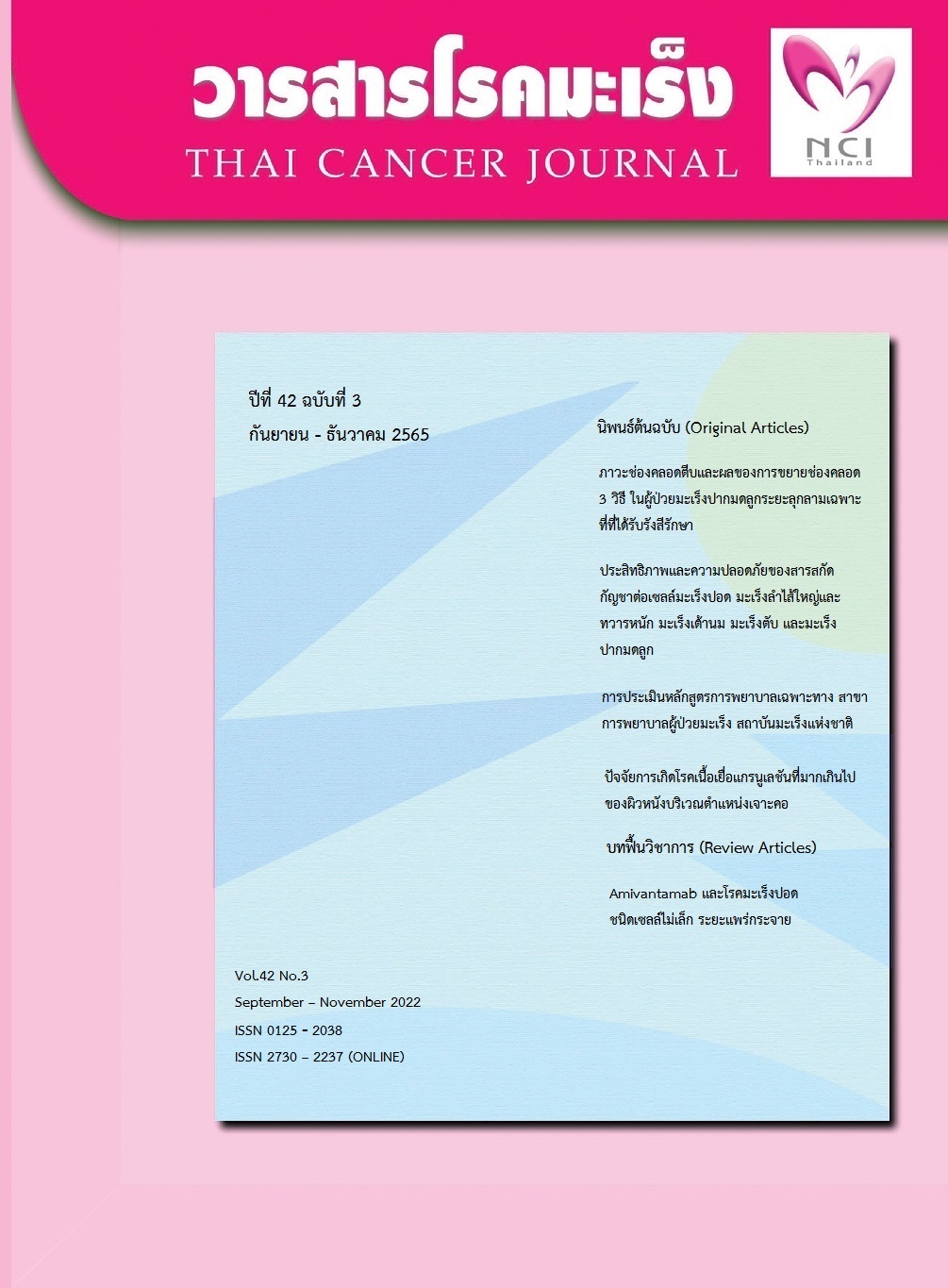Vaginal stenosis and the effect of 3 methods of vaginal dilationin patients with locally advanced cervical cancerreceiving radiotherapy
Keywords:
vaginal stenosis, vaginal dilation, vaginal dilator, locally advanced cervical cancer, radiotherapyAbstract
This prospective analytic study vaginal stenosis and the effects of three methods of vaginal dilatation in patients receiving radiotherapy for locally advanced cervical cancer. This study aimed to compare the differences in vaginal length and vaginal stenosis between groups who enlarged the vagina with fingers who used curved and straight vaginal dilators were compared for differences in satisfaction with the use of both types of vaginal dilators. The sample included 97 cervical cancer patients who were divided into 3 groups receiving concurrent chemoradiation as the definitive treatment at the National Cancer Institute of Thailand. Data were collected using the vaginal stenosis record developed by the researcher, and the satisfaction with the questionnaire. Data were analyzed using descriptive statistics and one-way Analysis of variance (ANOVA), and Analysis of Covariance (ANCOVA) statistical procedures. The results indicated that the average vaginal length of the straight vaginal dilator was more effective than compared of the curved dilator. The group using curved and straight vaginal dilators averaged less vaginal length reduction than the group using finger to dilate the vagina (F=42.35; P<.001). and when comparing the satisfaction of samples with the curved and straight vaginal dilators. It was found that samples were more satisfied with the curved vaginal dilator than the straight dilator
References
Law E, Kelvin JF, Thom B, Riedel E, Tom A, Carter J, et al. Prospective study of vaginal dilator use adherence and efficacy following radiotherapy. Radiother Oncol. 2015; 116(1):149-55.
Varytė G, Bartkevičienė D. Pelvic radiation therapy-induced vaginal stenosis: A review of current modalities and recent treatment advances. Medicina (Kaunas). 2012;57(4):336.
International Clinical Guideline Group. International guidelines on vaginal dilation after pelvic radiotherapy. Owen Mumford; Oxon, UK: National Forum of Gynecological Oncology Nurses; 2012.
Matos SRL, Lucas Rocha Cunha M, Podgaec S, Weltman E, Yamazaki Centrone AF, Cintra Nunes Mafra AC. Consensus for vaginal stenosis prevention in patients submitted to pelvic radiotherapy. PLoS One. 2019;14(8):e0221054.
Morris L, Do V, Chard J, Brand AH. Radiation-induced vaginal stenosis: current perspectives. International Journal of Women's Health. 2017;9:273-79.
Williamson CW, Kotha NV, Morris K, Simoes-Torigoe R, Kohanfars M, Chen J, et al. Radiation-induced vaginal stenosis in patients with locally advanced cervical cancer. Int J Radiat Oncol Biol Phys. 2021;111(3):e624-25.
Yoshida K, Yamazaki H, Nakamura S, Masui K, Kotsuma T, Akiyama H, et al. Longitudinal analysis of
late vaginal mucosal reactions after high-dose-rate brachytherapy in patients with gynecological cancer.Anticancer Research. 2014;34(8):4433-38.
Kirchheiner K, Nout RA, Lindegaard JC, Haie-Meder C, Mahantshetty U, Segedin B, et al. Dose-effect relationship and risk factors for vaginal stenosis after definitive radio(chemo)therapy with image-guided brachytherapy for locally advanced cervical cancer in the EMBRACE study. Radiother Oncol. 2016;118(1):160-6.
Yoshida K, Yamazaki H, Nakamura S, Masui K, Kotsuma T, Akiyama H, et al. Role of vaginal pallor reaction in predicting late vaginal stenosis after high-dose-rate brachytherapy in treatment-naive patients with cervical cancer. Journal of Gynecologic Oncology. 2015; 26(3):179-84.
Kachnic LA, Bruner DW, Qureshi MM, Russo GA. Perceptions and practices regarding women’s
vaginal health following radiation therapy: a survey of radiation oncologists practicing in the United States. Pract Radiat Oncol. 2017;7(5):356-63.
Vagal M, Shrivastava S, Mahantshetty U, Gupta S, Chopra S, Engineer R, et al. A retrospective study of vaginal stenosis following treatment of cervical Cancers and the effectiveness of rehabilitation interventions. Int J Med Health Sci. 2017;11(3):94-9.
ธวัชชัย วรพงศธ และสุรีย์พันธุ์ วรพงศธร. การคํานวณขนาดตัวอย่างสําหรับงานวิจัยโดยใช้โปรแกรมสําเร็จรูป G*Power. วารสารการส่งเสริมสุขภาพและอนามัยสิ่งแวดล้อม. 2561;41(1):11-21.
Cohen J. Quantitative methods in psychology: A power primer. Psychological Bulletin. 1992;112(1):155-9.
ประคอง กรรณสูต. สถิติเพื่อการวิจัยทางพฤติกรรมศาสตร์. กรุงเทพฯ : สำนักพิมพ์แห่งจุฬาลงกรมหาวิทยาลัย.มหาวิทยาลัยสุโขทัยธรรมาธิราช; 2542.
Bhatla N, Berek JS, Cuello Fredes M, Denny LA, Grenman S, Karunaratne K, et al. Revised FIGO.staging for carcinoma of the cervix uteri. Int J Gynaecol Obstet. 2019;145(1):129-35.
Charatsi D, Vanakara P, Evaggelopoulou E, Simopoulou F, Korfias D, Daponte A, et al. Vaginal dilator use to promote sexual wellbeing after radiotherapy in gynecological cancer survivors. Medicine (Baltimore). 2022;101(4):e28705.
Downloads
Published
Issue
Section
License
Copyright (c) 2022 Thailand's National Cancer Institute Foundation

This work is licensed under a Creative Commons Attribution-NonCommercial-NoDerivatives 4.0 International License.
บทความทีตีพิมพ์ในวารสารโรคมะเร็งนี้ถือว่าเป็นลิขสิทธิ์ของมูลนิธิสถาบันมะเร็งแห่งชาติ และผลงานวิชาการหรือวิจัยของคณะผู้เขียน ไม่ใช่ความคิดเห็นของบรรณาธิการหรือผู้จัดทํา







